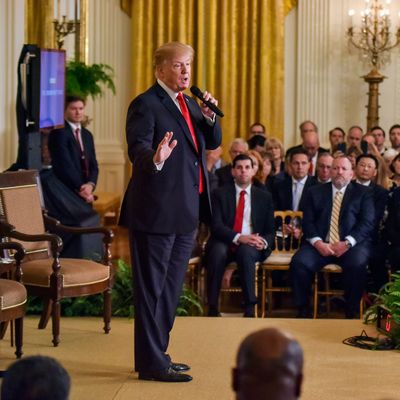
The Trump administration finally has an ambitious, detailed plan for combating the opioid epidemic, one that includes some evidence-based reforms that public-health experts have been recommending for years — and, also, the death penalty for low-level drug dealers. Or, at least, so Politico’s summary of the yet-to-be-finalized plan suggests.
Rarely, if ever, has a policy proposal been this simultaneously encouraging and horrifying. To this point in his presidency, Donald Trump has displayed so much callous indifference to the opioid crisis, it was far from certain that he’d ever produce any remotely serious blueprint for combating it. Last year, Trump declared the opioid epidemic a national public-health emergency — and then declined to call for any new funding to mitigate it, even as his administration encouraged Congress to slash $1 trillion from Medicaid (which funds addiction treatment for low-income Americans) and to add $1.5 trillion to the deficit for tax cuts. Since then, the White House has (ostensibly) ignored the recommendations of its opioids commission, and put Kellyanne Conway — a career pollster with no experience in public health — in charge of coordinating the administration’s policy response to a drug-overdose epidemic.
Given this track record, the fact that Trump’s plan (reportedly) includes the following sound, serious measures is pleasantly surprising.
Providing Medicaid enrollees with easier access to in-patient addiction treatment.
A half-century ago, amid the backlash to the mass institutionalization of the mentally ill, Congress passed a rule barring Medicaid from funding residential addiction treatment at large facilities. Some states have already received federal waivers exempting them from this prohibition. But the law remains in force throughout most of the country, and prevents many low-income opioid addicts from accessing treatment. Repealing it might seem like a no-brainer, but precisely because doing so would expand access to treatment, the reform would cost the government billions of dollars — and, to this point, the administration has been reluctant to increase federal spending on health care merely because 60,000 Americans are now dying of drug overdoses each year.
Raising standards for opioid prescriptions that are reimbursed by federal programs.
The White House plan would reportedly make Medicare and Medicaid more selective about the kinds of opioids prescriptions they’re willing to fund. According to Politico, the plan would require “75 percent of opioid prescriptions reimbursed by government health programs like Medicare and Medicaid to be issued by using ‘best practices’ within three years. That would be scaled up to 95 percent of prescriptions in five years.” Given the paucity of evidence demonstrating that opioids are an effective treatment for chronic pain, there is some rational basis for discouraging their use. That said, this particular approach is opposed by many physicians, including eight who participated in drafting the CDC’s 2016 guidelines on prescribing opioids for chronic pain.
Massively expanding the availability of naloxone.
Many states and municipalities have already taken action to equip police officers and other first responders with the lifesaving anti-overdose drug. But Trump’s plan would ostensibly provide federal funding to scale up these efforts. This would be an obvious piece of any remotely serious opioids plan, but there was some reason to fear that the conservative movement’s allergy to “harm reduction” approaches to drug abuse would keep it off of the White House’s list.
Encouraging states to opt into a drug-monitoring database that allows doctors to identify patients who have been seeking multiple opioid prescriptions from a variety of providers.
Screening inmates for opioid use upon their arrival to federal prison.
This would provide inmates who have serious opioid problems with residential treatment.
Alas, these sensible (if inadequate) proposals are paired with Draconian ones that would accomplish nothing beyond exacerbating our nation’s mass-incarceration problem and expanding the reach of (the moral abomination that is) the death penalty.
On the first point: The plan would make it easier to impose mandatory minimum sentences on “drug traffickers who knowingly distribute illegal opioids that can be lethal.” There is no reason to believe that this would deter opioid trafficking — according to the 2014 findings of the National Research Council, applying a mandatory minimum to a given offense does not reduce its prevalence. As criminologists have long demonstrated, potential criminal offenders are not (generally) deterred by the severity of the statutory punishment for a given illegal act, but only the “certainty of apprehension.” Which makes sense: It is hard to believe that anyone has ever decided whether to traffic fentanyl by consulting federal sentence guidelines, and carefully calculating exactly how many years in prison they’re prepared to serve; but it’s somewhat easier to imagine them making that decision after considering whether they know anyone who has made a lot of money dealing fentanyl and has not gotten caught.
Anyhow, sentences for drug crimes (and virtually all other crimes) in the United States are already exceptionally long by international standards — a fact that has gifted our nation with the highest incarceration rate in the world.
Finally, the administration’s proposal to make the death penalty an option in “certain cases where opioid, including Fentanyl-related, drug dealing and trafficking are directly responsible for death” is even more abominable. As written, the proposal would seem to potentially apply to even low-level drug dealers who sell opioids that result in someone’s death. Again, there is no evidence that this would deter the sale of fentanyl. And even if one finds the death penalty morally unobjectionable in theory, in practice, it simply can’t be: Between 1973 and 2004, at least 117 convicts sentenced to death were later found innocent of their alleged crimes. One might think that our president would be sensitive to the risk of misapplying the death penalty, seeing as he personally called for the execution of five teenage rape suspects who were later exonerated (but one, of course, would be wrong).
It’s likely that Trump’s proposal would be found unconstitutional. If not, it would make America an even crueler and more unusual place than it already is.






























